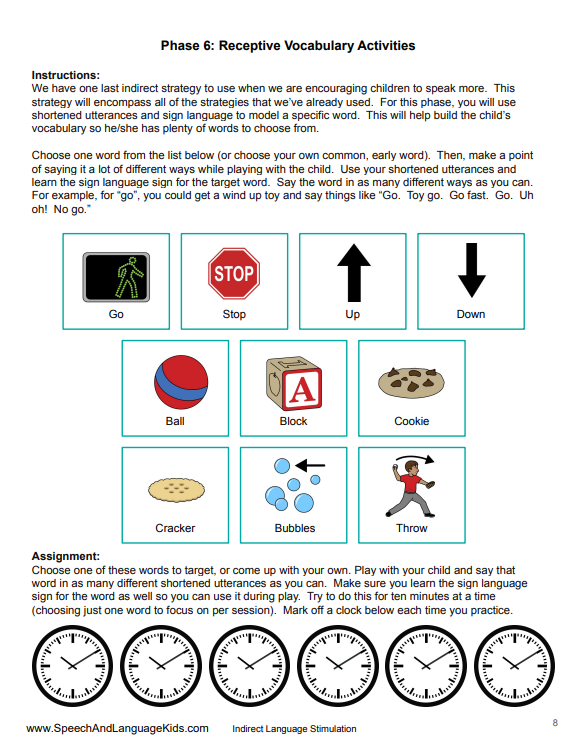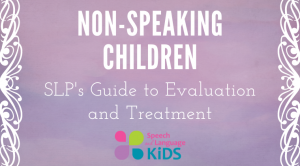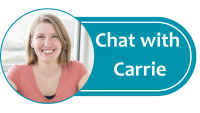How to Help a 3-year-old with Speech Delay:
When it comes to speech and language skills, a 3-year-old should have a word for just about everything around him and he should be able to put those words together to make short sentences. His speech should also be understood at least half of the time. Not all children will hit these milestones exactly on time but if a 3-year-old is still pretty far off from this point, he may have a speech delay.
Does my 3-Year-Old have a Speech Delay?
A speech delay is a general term that we use to describe when young children aren’t hitting their speech and language milestones on time. When they get older, we may classify them as having a phonological disorder or an expressive language delay, but when they are young, we’re not always sure just quite what is going on yet. For these children, we may use the general term of speech delay and then start working on whatever specific challenges they are having.
Here are a few markers to help you understand what speech skills a toddler or young child should have at each age. For in-depth information on speech/language milestones, click on the age:
- 1 year old: Should be interested in interacting with others and may speak his/her first word around 1 year
. - 2 years old: Should know more than 50 words now and should be able to put two words together, like “mommy go”
. - 3 years old: Should have a word for just about everything and should be able to put 3 words together to make a sentence
. - 4 years old: Should be able to speak in 4-word sentences and should be understood at least 75% of the time
. - 5 years old: Should be using grammatically correct sentences and should be understood at least 90% of the time
Is my 3-Year-Old a Late Talker?
We use the term late talker to describe a child who isn’t meeting their speech milestones above but who seem to be developing other skills on track. These children often understand what is being said to them and have good play and motor skills. They are simply lacking in their speech development. This can happen for a variety of reasons and some late talkers will go on to develop typical speech on their own. Others will require a little boost from speech therapy services to get going. The treatment strategies on this page are perfect for late talkers!
Speech Delay Treatment: What Can We Do in Therapy or at Home?
Children with speech delays should be evaluated by a speech-language pathologist or professional in your area. This person will be able to assess all areas of communication and determine the best treatments and therapies for each child. However, there are several treatment strategies that should be used with all children with speech delay. These can (and should!) be used both in therapy and at home to help boost the speech and language skills of a young child with a speech delay.
Check out our speech delay treatment strategies below:
Speech Delay Treatment Strategy 1:
Self Talk
Talk about what you are doing. Describe what you are holding, the actions you are performing, what you see, how you feel, and what you hear, smell, or taste. Talk about all of this! The child will learn from hearing you talk about all of those things. The key here is to keep your utterances short. As a general rule, you should speak in phrases that are the same length as the child’s or slightly longer.
For example, if the child isn’t talking yet or is only using one word at a time, you should be speaking in one-word phrases and two-word phrases, like “Ball. Throw. Throw ball. Ball”. If the child is using mostly single words but is beginning to put a few two-word phrases together, use a lot of two-word phrases when you speak to the child but also throw in some three-word utterances as well as a few one-word utterances. Don’t be afraid to repeat those same words many times. Our children learn best through repetition!
Speech Delay Treatment Strategy 2:
Use Sign Language
In this strategy, you will continue to use the self-talk described above but you will pair your spoken word with a sign language sign. Researchers have found that sign language serves as a great tool to get kids talking (or talking more), especially late talkers. Once the learn the power of communication through signing, they soon abandon signs for spoken language, as that will always be a more effective way to communicate for them. Click here to learn more about using sign language and to download our free sign language flashcards.
Speech Delay Treatment Strategy 3:
Parallel Talk
This strategy is very much like the “Self-Talk” strategy but instead of talking about what you are doing, you will be talking about what the child is doing. You can label the objects the child is using, the actions she is doing, how she’s feeling, what she hears, etc. Be sure that you’re continuing to use sentences that are right at or slightly above the length of sentences that the child is using, even if that’s only one or two words long.
Speech Delay Treatment Strategy 4:
Expansions
In this strategy, you will build on the child’s speech or gestures by using expansions. Take whatever the child says and add one word onto it. If the child says “ball”, you could say “want ball”, “my ball”, “yellow ball”, “throw ball”, or anything else that contains the word ball with one other word. You could even use two or three different examples.
If the child is not saying anything yet, you can build on his gestures. Whenever he points at something or makes a gesture to try to communicate something with you, say the word that goes along with that gesture. You can name the thing he’s pointing at or reaching for, label the emotion he’s feeling, or anything else you feel like the child is trying to communicate.
Speech Delay Treatment Strategy 5:
Receptive Vocabulary Building
In this strategy, you will work to increase the child’s receptive vocabulary. Receptive vocabulary includes all of the words the child understands when you say them, even if she’s not saying them herself yet. Children must first understand words before they can use them. You can increase the child’s receptive vocabulary by having him point to pictures, objects, or people when you label them for her.
For example, you can say “where’s Daddy?” and help her point or look towards Daddy. This is a great one to do while reading books. You can ask the child to point to an object in the book by saying “where’s the ___”, “show me the ____” or “point to the ____”. Give the child a bit of wait time, and if she can’t find it, then you can point it out for her and help her point to it as well. Keep doing this and soon the child will begin to understand more words.
Our Best Resources for Helping your 3-Year-Old with Speech Delay:
Inside The Hub, you’ll find everything you need to help a child with a speech delay at home, in the classroom, or in speech therapy. We provide you with the training you need to confidently support these children. We’ll also give you pre-made therapy materials and activities so you can get results faster. Join The Hub today to access all of the resources!

About the Author: Carrie Clark, MA CCC-SLP
Hi, I’m Carrie! I’m a speech-language pathologist from Columbia, Missouri, USA. I’ve worked with children and teenagers of all ages in schools, preschools, and even my own private practice. I love digging through the research on speech and language topics and breaking it down into step-by-step plans for my followers.
Fun Fact: My great grandfather was full-blooded Cherokee. That makes me 1/8th Native American, though I don’t identify with that as my background as I wasn’t raised in that culture.
Connect with Me:









[…] How to Help a Child with a Speech Delay « Speech and Language … […]
Hi Carrie, I am a primary school special ed teacher in Ireland and I must say I am over the moon to have found your website. It is so comprehensive and relevant to what I do that I don’t know how I managed without it! and it’s all FREE! Im super excited! I should really go to sleep but I can stop reading and thinking of ways I can use your advice to help my pupils. Thank you for sharing your wealth of knowledge. A big thank you from Ireland.
Go raibh mile maith agat (Thanks a million)
Emer
You are so welcome!! I stay up at night getting super excited about what else I can create for all of you so I’m glad to hear that someone else is as excited as I am! If you ever think of anything you need, please shoot me an email so I can add it to the list! Carrie@speechandlanguagekids.com
Carrie,
I found your website and I am so happy I did! My DD is 4 years old and is speech delayed, I thankfully have her in speech therapy twice a week. She went from not verbalizing to saying 3 to 4 word phrases but still wont answer questions she just repeats.. she pretty much repeats everything you ask her, mainly repeats questions or statements instead of answering them or agreeing. She is a very bright child and can memorize so well that she has started reading simple words like colors and animals. I just need some pointers on what I can do at home. Your flash card game has been printed and I will be using it tonight! I am very excited and wanted to thank you for being a light.
You are so welcome!! It is very normal for a child with a speech/language delay to be repeating everything. She just doesn’t have enough spontaneous words to be able to create her own productions yet! The speech therapy you have her in will help with that. Here’s more info on the repeating:
https://www.speechandlanguagekids.com/echolalia-when-children-repeat-what-you-say/
I’m a student who is following a degree speech and hearing sciences from Sri Lanka..The information u gave are most important to me as a student speech pathologist to upgrade my studies and clinical skills..thank u very much for this great work. And I would like to contact u personally as u wish.hope u may consider about my request thank u again
My granddaughter has been classed as speech delay she has many words but takes easier option drags you and points to what she wants niw preschool wants to label her special needs to get funds speech therapist says she doing fine what should we do
Hello Mary. Can she speak freely now after therapy. How long did she take to speak? Thanks
Hi Carrie,
Really excited to have stumbled on your website! I have an active three year old with delayed speech. He is echolalic and uses single words only. He plays happily with peers and produces unintelligible speech. Learning and basic recall is a difficulty. Which of your free resources is best to start with?
Thanks!
Hi, Evelyn-Here is a link to Carrie’s resources on Echolalia: https://www.speechandlanguagekids.com/?s=echolalia. You may want to start there. If you have additional questions, please email us at speechandlanguagekids@gmail.com.
Hi,
This is very helpful. My son is a somewhat late talker but he is just within the normal range. He has around 80 words at 22 months, and some two word sentences (mama help, where dada, I too), but seems to have little to no use for naming things and can’t yet say his own name. He keeps building and learning new words, slowly but steadily, but I am waiting for the language explosion that his friends are having and it’s not here. At what point do I have him evaluated? Is it ok to keep a wait-and-see approach at this point?
My Child is 6 years old -son. We have taking him to physical therapy since he was 3 years old. He Has changed but speech is what this really disturbing us. my wife and i have taken every caution but we are really worried that even at this age of 6. he cant pronounce full words,- construct a sentence.
Any idea on what to do? send it to zadteofilo@gmail.com
Hi, Shadrack-Here is a link to Carrie’s resources on Late Talking: https://www.speechandlanguagekids.com/late-talker-resource-page/. If you need further help, please email us at speechandlanguagekids@gmail.com.
Hi my son is 3years and 5months still he is not speaking well he knows 1 to 20 ABC and rhymes but what he needs he can’t say he doesn’t listen to me and no eye contact how I will start for him speech therapy
Hello, Farzana!
Thank you so much for reaching out. Unfortunately, we get a ton of questions every day about how to solve specific speech/language problems. Since we have such a small staff, we aren’t able to answer every question that comes through on the website, social media, or via email. If you are a parent, we suggest you reach out to a local speech-language pathologist who can work with your child directly and answer your question.
If you are another speech-language professional, we have created a membership where we pay a full staff to answer questions like this on a regular basis. We would be more than happy to answer your question inside the membership program. We’re able to answer more questions in here because we have a full library of questions that we’ve already answered so our staff can either link you to the answer if it exists, or write you a custom response if needed. We’d love to see you inside the membership!
Click Here to Become a Member: https://www.slpsolution.com/pediatric-signup/
My son is three years and is now slowly catching up more words. But my biggest worry is whether he will really be able to catch up especially when he starts preschool next year after we are done with the pandemic.
Hi my son is 2 years 4 months and says about 4 words daadaa , there, that and sometimes maamaa. He is however very sharp and understands dialogue and sentences. He is very clever in that he can from a process of elimination identify objects or people that you ask him about. He has very good retentive memory and remembers things taught ever since he was 1. However I am worried that there might be something wrong. Speech Therapy is on hold where we are due to Covid how can i help him?
Hi, Noonz-Here is a link from our site on later talkers: https://www.speechandlanguagekids.com/?s=late+talker. Please let us know of you need anything further.
hi thanks for sharing this post, very usefull
I am speech therapist in iran. I translated this to my language & share it.
good luck
That’s awesome! Please let us know if you have any questions.
These strategies broken down into shorts steps is super helpful, thanks!